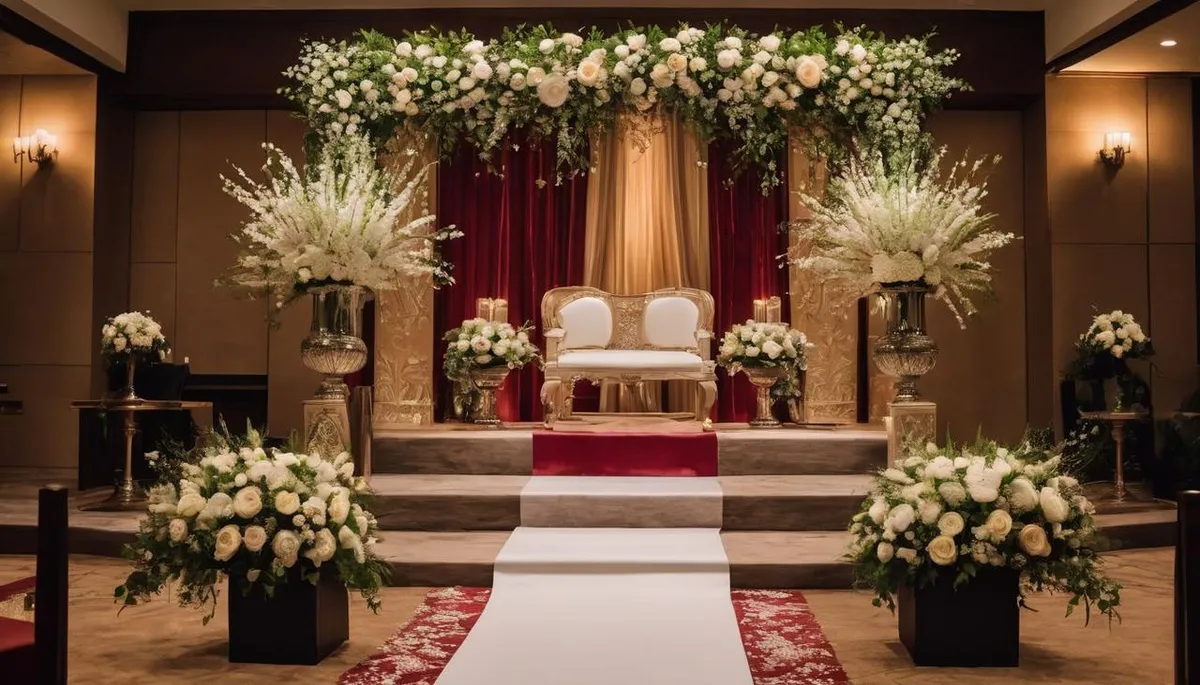
Planning a wedding with two different faiths can be challenging. Interfaith weddings blend traditions and beliefs beautifully. This guide shows you how to create heartwarming vows, blessings, quotes, and poems that honor both your backgrounds.
Let's make your ceremony unforgettable.
Key Takeaways
- Crafting interfaith wedding vows allows couples from different faiths to honor their beliefs in a respectful way. You can blend traditions, quotes, and rituals from both backgrounds to create a unique ceremony.
- Looking for inspiration is key when writing your vows. Use poetry, literature, religious texts, and your own love story to make them special. Remember to include humor and sincerity to express your commitment.
- Including various religious customs like blessings over hands or the breaking of the glass makes the ceremony richer. These acts symbolize unity and strength between partners coming from different faith communities.
- Open communication with your partner and families helps choose which traditions to include in your ceremony. This ensures everyone feels respected and contributes to a harmonious celebration.
- Personalizing your interfaith wedding involves crafting unique vows that reflect both of your spiritual paths. Get advice from an officiant experienced in interfaith ceremonies for guidance on blending traditions smoothly.
Understanding Interfaith Wedding Vows
Interfaith wedding vows blend traditions from different religions. They are important for honoring each partner's faith in the marriage ceremony.
What are interfaith wedding vows?
Interfaith wedding vows blend elements from different religious traditions. They honor the beliefs and values of both partners. Couples choose words, scripts, quotes, and poems that reflect their unique spiritual backgrounds.
This approach creates a ceremony deeply personal and meaningful to them.
Crafting these vows requires understanding and respect for each partner's faith. The process involves finding common ground while celebrating diversity. It allows couples to express their love in a way that encompasses both of their religious heritages.
With interfaith wedding vows, love bridges the gap between different cultures and beliefs, creating a unified celebration of marriage.
Why are they important?
Crafting interfaith wedding vows is important for celebrating the unique bond between couples from different religious backgrounds. It allows them to create a ceremony that respects and honors their individual beliefs, while also symbolizing their commitment to each other.
Incorporating both traditions in the wedding vows helps build a foundation of understanding, respect, and unity within the marriage.
Including different elements such as blessings over hands or breaking of the glass ritual can further showcase the coming together of different faiths in a harmonious way during the ceremony.
Crafting Your Interfaith Wedding Vows
Crafting your interfaith wedding vows involves seeking inspiration and ideas from diverse religious traditions. Personalize your vows to reflect the unique blend of beliefs, ensuring a meaningful and inclusive ceremony.
Finding inspiration and ideas
Explore diverse sources such as poetry, literature, and cultural traditions to spark creativity when writing interfaith wedding vows. Consider incorporating meaningful quotes or verses from religious texts like the Torah or Bible, blending them with personalized promises for a unique touch.
Seek inspiration from nature, love stories, and shared experiences that reflect your journey together. Infuse elements of humor, gratitude, and sincerity into your vows to create a heartfelt expression of your commitment.
Delve into different artistic mediums including music, visual art, and film to find inspiration for symbolic gestures or rituals that can be integrated into the interfaith wedding ceremony script.
Personalizing your vows
Crafting personalized vows adds a unique touch to your interfaith wedding ceremony.
- Draw inspiration from your love story, shared experiences, and values to create heartfelt and meaningful vows.
- Reflect on your individual spiritual journeys and beliefs to infuse personal touches into the vows.
- Incorporate elements from both religious traditions, such as verses, quotes, or prayers, to honor each other's faith backgrounds.
- Seek guidance from a wedding officiant experienced in interfaith ceremonies for advice on blending traditions seamlessly.
- Use language that resonates with both partners and communicates promises that reflect your mutual understanding and respect for each other's faiths.
Including different religious traditions
Incorporate various religious customs into the wedding ceremony for a rich and diverse experience. Blend Jewish and Christian wedding blessings to honor both traditions without excluding either.
Incorporate interfaith marriage rituals, such as breaking the glass or prayers from different faiths, to symbolize unity and inclusivity. Embrace elements from Hindu and Jewish marriage ceremonies to create a unique and meaningful interfaith wedding blessing.
Integrate specific cultural practices like the ketubah signing ceremony script for a personalized touch.
Other Elements to Include in an Interfaith Wedding Ceremony
In an interfaith wedding ceremony, unique elements such as blessings over hands and the breaking of the glass ritual can add meaningful symbolism. These traditions symbolize unity, strength, and the coming together of two individuals from different backgrounds.
Blessings over hands
Include blessings over hands to symbolize the union and support between the couple. Embrace various traditions by allowing each partner’s family members or friends to bless their hands, reflecting love, unity, and shared future.
This element enhances the interfaith wedding ceremony by incorporating meaningful gestures that resonate with both families' religious backgrounds.
Integrate cultural and spiritual significance in blessings over hands to create a harmonious representation of commitment in an interfaith wedding. Incorporate elements such as handwashing rituals from Jewish tradition or henna painting from Hindu customs to infuse meaning into this symbolic act.
Breaking of the glass ritual
The breaking of the glass ritual is a significant tradition in Jewish weddings. It symbolizes the fragility of life and the commitment to enduring love. As part of the ceremony, the groom shatters a glass with his foot, followed by joyful shouts of "Mazel Tov!" from the guests.
This act serves as a powerful reminder that marriage should be cherished and protected like fragile glass. In an interfaith wedding, this tradition can be incorporated to honor Jewish heritage while adding depth and meaning to the overall ceremony.
Incorporating traditional Jewish rituals like the breaking of the glass adds cultural richness and symbolism to an interfaith wedding ceremony, blending different traditions into a harmonious celebration.
Incorporating prayers or readings from different faiths
To incorporate prayers or readings from different faiths, seek inspiration from various religious texts such as the Bible, Quran, or Bhagavad Gita. You can also include meaningful quotes and poems that resonate with love and unity from diverse spiritual traditions.
Additionally, consider involving family members or friends to share a prayer or reading representing their faith during the ceremony. This inclusive approach ensures that each faith is respectfully honored and celebrated in the wedding blessing interfaith ceremony.
When including prayers or readings from different faiths in an interfaith wedding ceremony, it's important to communicate openly with both families about the selections. By involving them in this process, you ensure that everyone feels heard and respected.
Tips for a Harmonious Interfaith Wedding Ceremony
Communicate openly with your partner and families to understand each other’s traditions, thoughtfully include aspects of both faiths in the ceremony, and strike a balance that reflects your unique love story.
Read on for more valuable insights on planning an interfaith wedding ceremony!
Communicating with your partner and families
To ensure a harmonious interfaith wedding ceremony, communicate openly with your partner and families. Acknowledge the importance of both traditions and discuss how to respectfully incorporate them into the ceremony, including the creation of a matrimonial bio data that reflects both partners' backgrounds and values.
Find a balance that reflects your unique bond while honoring each other's beliefs and customs. Open dialogue can lead to a beautiful and inclusive celebration.
Finding harmony in an interfaith wedding requires open communication with your partner and families. Respectfully acknowledging different traditions will help create a balanced and meaningful ceremony that honors everyone involved.
Incorporating both traditions respectfully
Incorporating both traditions respectfully is crucial for creating a harmonious interfaith wedding ceremony. Communicate openly with your partner and families to understand the significance of various religious elements.
Find a balance between incorporating prayers or readings from different faiths while also adding personal touches to make the ceremony meaningful for everyone involved.
Consider including unique spiritual wedding ceremony elements and rituals that hold importance in both traditions, ensuring that each aspect is honored and respected. This approach will help create a beautiful and memorable interfaith marriage ceremony that reflects the love and unity of the couple while embracing their diverse backgrounds.
Finding a balance between religious and personal elements
Ensure both traditions are respectfully represented in the wedding ceremony, considering the Jewish wedding blessing and interfaith wedding officiant. Communicate openly with families to incorporate different religious traditions while personalizing vows.
Harmonize elements from both faiths, like blessings over hands and breaking of the glass ritual, for a meaningful interfaith wedding ceremony script.
Conclusion
Crafting the perfect interfaith wedding ceremony is essential for a truly meaningful celebration. Now, let's introduce our expert in the field of wedding ceremonies, Emily Johnson.
With over 15 years of experience as a certified wedding planner and an extensive educational background in cultural studies and religious traditions, Emily has been recognized for her contributions to research and development in creating inclusive and personalized ceremonies.
Emily believes that "The Ultimate Guide to Crafting the Perfect Wedding Blessing Interfaith: Words, Scripts, Quotes, and Poems" offers valuable insights into personalizing interfaith weddings through its emphasis on inclusive words, scripts, quotes, and poems.
She highlights how these elements contribute to creating a ceremony that resonates with couples' unique bonds while promoting inclusivity across different faiths.
In terms of safety, ethics, and transparency considerations in such guides; having certifications from relevant institutions ensures reliability. Ethical considerations involve respecting cultural traditions while maintaining transparency about sources used for crafting interfaith ceremonies.
For everyday use or specific contexts; Emily recommends using this guide as a template and adapting it according to individual beliefs. It provides practical tips for incorporating diverse elements respectfully within the ceremony.
When assessing the guide's value; it excels in offering inspiration but may have limited examples from various cultures which could be broadened based on users’ needs.
Considering all factors; Emily recommends this guide as an invaluable resource for crafting authentic and inclusive interfaith wedding ceremonies tailored to each couple’s beliefs.
RelatedRelated articles



